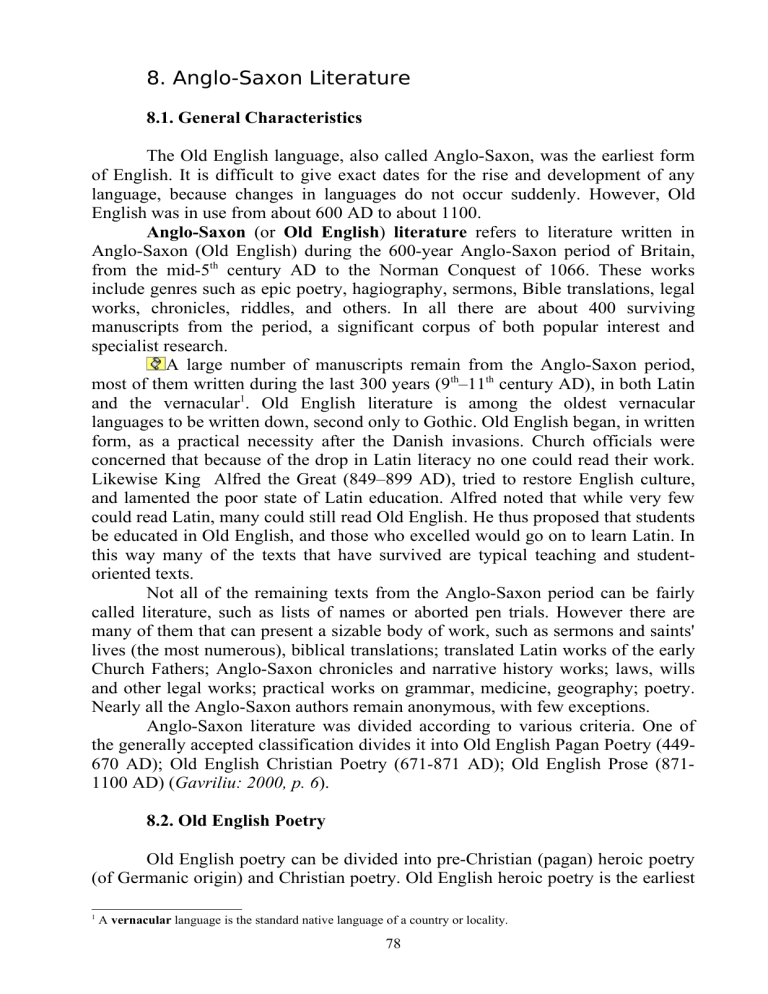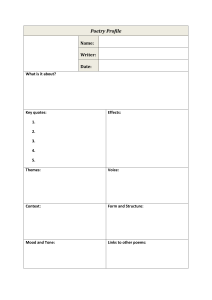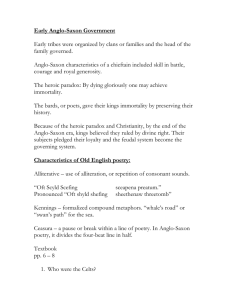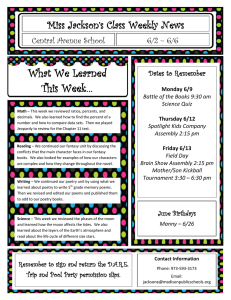
8. Anglo-Saxon Literature 8.1. General Characteristics The Old English language, also called Anglo-Saxon, was the earliest form of English. It is difficult to give exact dates for the rise and development of any language, because changes in languages do not occur suddenly. However, Old English was in use from about 600 AD to about 1100. Anglo-Saxon (or Old English) literature refers to literature written in Anglo-Saxon (Old English) during the 600-year Anglo-Saxon period of Britain, from the mid-5th century AD to the Norman Conquest of 1066. These works include genres such as epic poetry, hagiography, sermons, Bible translations, legal works, chronicles, riddles, and others. In all there are about 400 surviving manuscripts from the period, a significant corpus of both popular interest and specialist research. A large number of manuscripts remain from the Anglo-Saxon period, most of them written during the last 300 years (9th–11th century AD), in both Latin and the vernacular1. Old English literature is among the oldest vernacular languages to be written down, second only to Gothic. Old English began, in written form, as a practical necessity after the Danish invasions. Church officials were concerned that because of the drop in Latin literacy no one could read their work. Likewise King Alfred the Great (849–899 AD), tried to restore English culture, and lamented the poor state of Latin education. Alfred noted that while very few could read Latin, many could still read Old English. He thus proposed that students be educated in Old English, and those who excelled would go on to learn Latin. In this way many of the texts that have survived are typical teaching and studentoriented texts. Not all of the remaining texts from the Anglo-Saxon period can be fairly called literature, such as lists of names or aborted pen trials. However there are many of them that can present a sizable body of work, such as sermons and saints' lives (the most numerous), biblical translations; translated Latin works of the early Church Fathers; Anglo-Saxon chronicles and narrative history works; laws, wills and other legal works; practical works on grammar, medicine, geography; poetry. Nearly all the Anglo-Saxon authors remain anonymous, with few exceptions. Anglo-Saxon literature was divided according to various criteria. One of the generally accepted classification divides it into Old English Pagan Poetry (449670 AD); Old English Christian Poetry (671-871 AD); Old English Prose (8711100 AD) (Gavriliu: 2000, p. 6). 8.2. Old English Poetry Old English poetry can be divided into pre-Christian (pagan) heroic poetry (of Germanic origin) and Christian poetry. Old English heroic poetry is the earliest 1 A vernacular language is the standard native language of a country or locality. 78 extant in all of Germanic literature. It is thus the nearest we can come to the oral pagan literature of Germanic culture, and is also of inestimable value as a source of knowledge about many aspects of Germanic society. Old English heroic poetry falls into two categories: those poems presenting figures and events of the so-called heroic age and those describing contemporary events. The heroic age is a temporal construct that features people and tribes of the early European migration age. Heroic poems are written in an elegiac tone. They describe grim scenery: cliffs and swamps, grey waves crushing against the rocks, monsters living in the swamps and forests. A grim imagination, a pessimistic and sad world view led to the creation of these impressive pictures; we can recognize the imprint of a people that lived in a harsh environment. The sea is admirably described in many heroic or elegiac poems. The Anglo-Saxon poems have been often compared with Homeric poems, as they also illustrate the features of the heroic age (Maurois: 1970, pp. 70-71). Old English poetry has survived for the most part in four manuscripts. The first manuscript is called the Junius manuscript (also known as the Caedmon manuscript), an illustrated poetic anthology. The second is called the Exeter Book, also an anthology, located in the Exeter Cathedral since it was donated there in the 11th century. The third manuscript is called the Vercelli Book, a mix of poetry and prose; how it came to be in Vercelli, Italy, no one knows, and is a matter of debate. The fourth manuscript is called the Nowell Codex, and it is also a mixture of poetry and prose. The Nowell Codex is part of the Cotton collection1. Old English poetry had no known rules or system left to us by the AngloSaxons, and everything we know about it is based on modern analysis. The first widely accepted theory was by Eduard Sievers2 in which he distinguished five distinct alliterative patterns. The theory of John C. Pope3 uses musical notations which has had some acceptance. The most popular and well known understanding of Old English poetry continues to be Sievers’ alliterative verse. The system is based upon accent, alliteration4, the quantity of vowels, and patterns of syllabic accentuation. It consists of five permutations on a base verse scheme. The system was inherited and exists in one form or another in all of the older Germanic languages. Another common feature of Old English poetry is Kennings (figurative phrases), often formulaic, describing something in terms of another (e.g. in Beowulf, the sea is called the swan's road). Also frequently employed are Litotes, a figure of speech which is dramatically understated, often with ironic intent and effect. 1 The Cotton or Cottonian library was a library compiled by Sir Robert Bruce Cotton (1571 - 1631). This collection is the single greatest resource of literature in Old English and Middle English we have. 2 Eduard Sievers (25 November 1850, Lippoldsberg - 30 March 1932, Leipzig) was a German philologist, of the classical and Germanic languages. He developed a theory of the meter of Anglo-Saxon alliterative verse. 3 John C Pope developed a theory on the rhythm and tempo of Old English verse during recitation, together with Andreas Heusler. His system takes the musical concept of the measure as its basis and states that four isochronous (equally timed) measures are found in all lines. When a normal enunciation of the syllables in the half-line does not fill the measure, Pope has suggested that the harp would be struck to fill in the rest in the verbal music. 4 Alliteration, in Old English poetry, is the repetition of consonant sounds in stressed or initial syllables. (Gavriliu: 2003, p. 143) 79 Old English poetry was an oral craft, and our understanding of it in written form is incomplete. For example, we know that the poet, referred to as a Scop1, could be accompanied by a harp. There may be other audio traditions we are not aware of. Poetry represents the smallest amount of the surviving Old English text, but Anglo-Saxon culture had a rich tradition of oral story telling, just not much was written down or survived. Most Old English poets are anonymous. Twelve of them are known by name from medieval sources, but only three of those are known by their works to us today: Caedmon, Aldhelm, and Cynewulf. Caedmon is the most well known and considered the father of Old English poetry. He lived at the abbey of Whitby in Northumbria in the 7th century. Caedmon adapted the heroic vocabulary of the oldest English verse and the poetic technique of traditional Germanic versification to a Christian purpose. Some paraphrases or altered versions of his poems on biblical subjects are found in the Junius manuscript: Genesis (Genesis A contains the first 22 chapters of the Old Testament; Genesis B talks of the rebellion of the angels led by Satan); Exodus (a paraphrase of the crossing of the Red Sea by Israelites); Judith (the story of a Jewish heroine who helped her people defeat the Assyrians). Aldhelm, bishop of Sherborne2 (709 AD), is known thanks to William of Malmesbury3 who talked of his performance of secular songs. Most of his Latin prose has survived, but none of his Old English remains. Cynewulf has proven to be a difficult figure to identify, but recent research suggests he wrote his works in the early part of the 9th century, to which a number of poems are attributed including The Fates of the Apostles and Helene (both found in the Vercelli Book), and Christ II and Juliana (both found in the Exeter Book). The Old English poetry which has received the most attention deals with the Germanic heroic past. The longest (3,182 lines), and most important, is Beowulf, which appears in the damaged Nowell Codex from the Cotton Collection. It tells the story of the legendary Geatish hero Beowulf who is the title character. The story is set in Scandinavia, in Sweden and Denmark, and the tale likewise probably is of Scandinavian origin. The story is biographical and sets the tone for much of the rest of Old English poetry. It has achieved national epic status, on the same level as the Iliad, and is of interest to historians, anthropologists, literary critics, and students the world over. Other heroic poems include The Fight at Finnsburh, a retelling of one of the battle scenes in Beowulf (although this relation to Beowulf is much debated), and Waldere, a version of the events of the life of Walter of Aquitaine, a west 1 A Scop or a bard was a highly trained poet, composer, singer, and harpist who served as oral historian, political critic, eulogizer, and entertainer. 2 Sherborne is an affluent market town in North West Dorset, England. The town was named scir burne by the Saxon inhabitants, a name meaning clear stream. It became the capital of Wessex, one of the seven Saxon kingdoms of England, and King Alfred's elder brothers King Ethelbert and King Ethelbald were buried in its abbey. 3 William of Malmesbury (c. 1080/1095 AD– c. 1143 AD) was an English historian of the 12th century, born in Wiltshire. He spent his whole life in England with his best working years as a monk at Malmesbury Abbey. 80 Gothic hero. These two poems have survived in fragments. Other two poems mention heroic figures: Widsith and Deor’s Lament. Widsith is believed to be in parts very old, dating back to events in the 4th century concerning Eormanric1 and the Goths. The narrator, Widsith, is a travelling minstrel who wondered away from his tribe and speaks of the princes who have given him presents. Some seventy tribes and sixty-nine heroes, many of whom are proved to have existed, appear in this epic poem. Deor’s Lament is a lyric, applying examples of famous heroes, including Weland2 and Eormanric, to the narrators own case. Deor is taken up with stories of misfortune, which are brought forward in illustration of the poet’s troubles. The strophic form is preserved throughout and, except in the last fifteen lines, which seem to have been somewhat remodelled, each strophe ends with a refrain. The Anglo-Saxon Chronicle contains various heroic poems inserted throughout. The earliest from 937 AD is called The Battle of Brunanburh, and celebrates the victory of King Athelstan over the Scots and Norse. There are five shorter poems: capture of the Five Boroughs; coronation of King Edgar; death of King Edgar; death of Prince Alfred; death of King Edward the Confessor. The 325 line poem Battle of Maldon celebrates Earl Byrhtnoth3 and his men who fell in battle against the Vikings in 991. It is considered one of the finest, but both the beginning and end are missing and the only manuscript was destroyed in a fire in 1731. Old English heroic poetry was handed down orally from generation to generation. As Christianity began to appear, re-tellers often recast the tales of Christianity into the older heroic stories. While Beowulf, The Fight at Finnsburh/ Finnesburgh, and Widsith are epic poems, Deor’s Lament, Wulf and Eadwacer, The Wife’s Lament/ Complaint, The Husband’s Message, The Wanderer, The Seafarer and The Ruin fall under the category of lyrical poetry. They are mostly elegies or wisdom poems and some are remarkable in quality and expression. Besides enumerating historical and fictional characters, Deor’s Lament contains the story of Deor, a scop who was dismissed by his lord in favour of his rival, Heorrenda. Deor takes consolation in the stories of other victims of fortune such as himself. The theme of the seven-stanza poem could be the futility of life and glory. Each of the seven stanzas ends with a refrain which is characteristic to many Old English lyrical poems. (Gavriliu, Universitatea Dunarea de Jos, Galati, 2000, pp.11-12) Wulf and Eadwacer is a 19-line poem found in the Exter Book. It contains the lament of a woman who longs for someone named Wulf, a son or a lover. Like Deor’s Lament, this poem also has a refrain. The woman is either a prisoner, either the unfortunate wife of Eadwacer, and dreams of escaping and meeting her 1 Eormanric the Goth, a Gothic king, was defeated by the Huns. In Scandinavian, Germanic, and Anglo-Saxon legends Weland / Wayland is a smith of outstanding skill. 3 Earl Byrhtnoth was a royal deputy in Essex. In 991 AD he refused to pay the money demanded by the Viking invaders and fought them to death. 2 81 beloved Wulf again. (Oltean, Dunăreanu, Universitatea Babeş-Bolyai, ClujNapoca, 1977, p. 10) The Wife’s Lament (written around 900 AD) is an elegy found in the Exter Book. It contains the lament of a woman who is separated by her husband because of his hostile family. She is forced to live in a cave in the forest and she cries her sorrow while remembering the man she loves and hoping he also longs for her. (Gavriliu: 2000, p. 12) The Husband’s Message (written around 950 AD), also found in the Exter Book, has come down to us in bad shape, as it has several burn-marks. It contains the message of an exile towards his lady by means of runes carved in wood. The husband tells his beloved to join him in spring, when the cuckoo sings. Melancholy is not found in this poem, as in almost all lyrical Old English poems. (Gavriliu: 2000, p.12) The Wanderer (725 AD), found in the Exter Book, is a sad song of a young thane who has lost his lord and fellows in arms. He remembers them while sailing on wintry weather and holds the pain in his soul, as he knows a warrior should never show his grief. (Gavriliu: 2000, p.13) The Seafarer (725 AD, Exter Book) is the only Old English poem that deals exclusively with the sea. It is a poem of about the same length as The Wanderer and resembles it in several passages rather closely. The sequence of thought, however, is much less clear. The poet begins by reflecting on the miseries which he has endured when travelling by sea, yet later on in the poem he says that he has an irresistible impulse to try the seaman’s life. The Seafarer was considered to have both pagan and Christian influences (the content was of heathen origin, and a Christian conclusion was later added). It is the story of a seaman who remembers all his suffering while at sea. Despite the hardships of the sea, he remains attracted to it and always returns to it. (Gavriliu: 2000, p.13) The Ruin (written around 700 AD), also found in the Exter Book, is a fragment containing a lament written to the ruins of a Roman Celtic town. It is the first of many English meditations on old stones. The city in the poem could be Aquae Sulis, the Roman Bath. The Roman ruins were called the work of giants by Anglo-Saxons, because the Romans introduced for the first time the art of massive constructions in stone to Britain. (Oltean, Dunăreanu: 1977, p. 10) Several Old English poems are adaptations of late classical philosophical texts. The longest is a 10th century translation of Boethius' Consolation of Philosophy contained in the Cotton manuscript. Another is The Phoenix in the Exeter Book, an allegorization of the De ave phoenice by Lactantius. Other short poems derived from the Latin bestiary tradition such as The Panther, The Whale and The Partridge. The Psalter Psalms 51-150 are preserved, following a prose version of the first 50 Psalms. It is believed there was once a complete Psalter based on evidence, but only the first 150 have survived. There are a number of verse translations of the Gloria in Excelsis, the Lord's Prayer, the Apostles Creed as well as a number of hymns and proverbs. 82 In addition to Biblical paraphrases there are some original religious poems, mostly lyrical (non-narrative). Considered one of the most beautiful of all Old English poems is Dream of the Rood, contained in the Vercelli Book. It is a dream vision of Christ on the cross, with the cross personified and speaking. It is divided into three parts: the vision of the Cross, its speech and the concluding reflections of the dreamer. The Cross is seen as a faithful retainer, but in order to obey its Lord, it has to become his slayer. The poem has quite a few apocalyptic elements, like the idea that the Cross is a salvation instrument before judgement. There are a number of religious debate poems. The longest is Christ and Satan in the Junius manuscript; it deals with the conflict between Christ and Satan during the forty days in the desert. Another debate poem is Solomon and Saturn, surviving in a number of textual fragments; Saturn is portrayed as a magician debating with the wise king Solomon. Old English miscellaneous poetry consists in minor pieces of popular literature, not destined for recitation in kings’ halls, but spread among common people. The Exeter Book has a collection of ninety-five riddles. The answers are not supplied, and a number of them to this day remain a puzzle. There are short verses found in the margins of manuscripts which offer practical advice (charms). There are remedies against the loss of cattle, how to deal with a delayed birth, swarms of bees, etc. The longest is called Nine Herbs Charm and is probably of pagan origin. There are also a group of mnemonic poems designed to help memorize lists and sequences of names and to keep objects in order. These poems are named Menologium, The Fates of the Apostles, The Rune Poem, The Seasons for Fasting, and the Instructions for Christians. 8.3. Anglo-Saxon Prose The amount of surviving Old English prose is much greater than the amount of poetry. Of the surviving prose, sermons and Latin translations of religious works is the majority. Old English prose first appeared in the 9th century, and continued to be recorded through the 12th century. The first known Anglo-Saxon prose writer was Aldhelm, the founder of Malmesbury Abbey and later bishop of Sherborne. His works were written in Latin and consisted in Letters and Riddles. His style was heavily decorated with complex metaphors. (Gavriliu: 2000, p. 18) King Alfred the Great (871 – 899 AD) tried to save his country from barbarism and ignorance by encouraging his people to study at his schools and monasteries. Scholars such as Johannes the Saxon, Grimbald from Flanders, or Denwulf from Winchester came to teach in his schools. Alfred learned Latin and translated into Old English many Latin writings. The translations of The Pastoral Care (a manual for priests on how to conduct their duties), The History of the World by Orosius, The Consolation of Philosophy by Boethius, The Soliloquies of Saint Augustine, The Ecclesiastical History of the English People by Bede 83 have been traditionally associated with King Alfred, but the style and language used in each is so different that it is more likely that they were written by different people, and even in different time periods. (Gavriliu: 2000, p. 19) During Alfred’s reign, the capital of Winchester became a great cultural centre. Alfred also collected in a Law Book all the laws existing in England at that time. He is the initiator of the keeping of the Anglo-Saxon Chronicle, the first historical record ever composed in English. (Gavriliu: 2000, p. 19) The Anglo-Saxon Chronicle was started in the time of King Alfred, around 891 AD. These prose Annals started with Caesar’s invasion, up to the reign of Alfred. Much of the information in these documents may be unreliable. However for some periods and places, the chronicle is the only substantial surviving source of information. After the original chronicle was compiled, copies were kept at various monasteries and were updated independently. There are nine surviving manuscripts (including two copies), of which eight are written entirely in Anglo-Saxon, while the ninth is in Anglo-Saxon with a translation of each annal into Latin. One (the Peterborough Chronicle) contains early Middle English as well as Anglo-Saxon. It extends down to the death of King Stephen in 1154, and is the longest of the Annals. The oldest (Corp. Chris. MS 173) is known as the Parker Chronicle, after Matthew Parker who once owned it, or the Winchester Chronicle. Aelfric (955 – 1020 AD), Abbot of Eynsham, wrote his works in the second half of the 10th century. He was the greatest and most prolific writer of Anglo-Saxon sermons, which were copied and adapted for use well into the 13th century. He also wrote a number of saint’s lives, an Old English translation of the Rule of Saint Benedict, pastoral letters, translations of the first six books of the Bible, glosses and translations of other parts of the Bible, a Colloquium for teaching Latin conversation, and a vocabulary (the first Latin-English dictionary). A contemporary of Aelfric was Wulfstan II, Archbishop of York and Bishop of Worchester. His sermons were highly stylistic. His best known work is The Sermo Lupi ad Anglos (Wulf’s Sermon to the English) in which he blames the sins of the British for the Viking invasions. He also wrote a number of clerical legal texts: The Institutes of Polity and The Canons of Edgar. Martyrology (information about saints and martyrs according to their anniversaries and feasts in the church calendar) was written around the 9th century AD by an anonymous Mercian author, and has survived in six fragments. The oldest collection of church sermons is the one known as the Blickling homilies, found in the Vercelli Book and written around the 10th century AD. There are a number of saint's lives prose works beyond those written by Aelfric: the prose life of Saint Guthlac (Vercelli Book), the life of Saint Margaret and the life of Saint Chad. There are four saint’s lives in the Junius manuscript: Seven Sleepers of Ephesus, Saint Mary of Egypt, Saint Eustace and Saint Euphrosyne. There were also many Old English translations of different parts of the Bible. Aelfric translated the first six books of the Bible (the Hexateuch). There are some translations of the Gospels; the most popular is the Gospel of Nicodemus, 84 while others include the Authentic Gospel of Matthew, Vindicta salvatoris, Vision of Saint Paul and the Apocalypse of Thomas. A single example of a classical romance has survived; it is a fragment of a Latin translation of Apollonius of Tyana by Philostratus (220 AD), from the 11th century. Byrhtferth of Ramsey, a monk who was contemporary to Aelfric and Wulfstan, wrote two books, a Handboc and a Manual. These were studies of mathematics and rhetoric. Aelfric didn’t only write religious works. He is also the author of two neo-scientific works, Hexameron and Interrogationes Sigewulfi, dealing with the stories of Creation. He even wrote a grammar and glossary in Old English, called Latin, and later used by students interested in learning Old French because it had been glossed in Old French. The legal texts written in Old English also come in great numbers. They include records of donations by nobles, wills, documents of emancipation, lists of books and relics, court cases, guild rules. All of these texts provide valuable insights into the social history of Anglo-Saxon times, but are also of literary value. By the 12th century they had been arranged into two large collections which included the laws of the kings, beginning with those of Aethelbert of Kent, and texts dealing with specific cases and places in the country. There is also a large volume of legal documents related to religious houses. There are a number of interesting medical works in Old English. There is a translation of Apuleius's Herbarium with striking illustrations, found together with Medicina de Quadrupedibus. A second collection of texts is Bald's Leechbook, a 10th century book containing herbal and even some surgical cures. A third collection is known as the Lacnunga, and relies on charms, incantations, and white magic. 85




